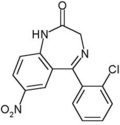SAN FRANCISCO -- Small doses of clonazepam may reduce neurally mediated symptoms in patients with chronic fatigue syndrome, a small uncontrolled trial suggests.
Neurally mediated symptoms declined in 13 patients who were treated with 0.25-0.75 mg/day (a mean of 0.41 mg/day) of clonazepam. Prospective, placebo-controlled trials are needed to confirm these findings, Dr. Tom T. Hee said in a poster presentation at the annual meeting of the American College of Chest Physicians.
All of the patients had been diagnosed with chronic fatigue syndrome and were referred to the cardiac center at Creighton University, Omaha, Neb., for neurally mediated symptoms including orthostatic presyncope in eight patients and weakness, exercise intolerance, and inability to participate in normal day-to-day activities in all 13 patients, said Dr. Hee of the university.
On clonazepam, the frequency of orthostatic presyncope decreased from daily episodes to 0-2 episodes per month in seven (88%) of eight patients with the symptom. Symptoms as a whole declined enough in 12 patients (92%) that they were able to resume their normal lifestyles.
The symptoms were reproduced by head-up tilt table tests in 10 of 13 patients before treatment with clonazepam. After treatment, one patient continued to have abnormal head-up tilt table results, six had normal results, and three showed some improvement in their ability to tolerate the tilt table for longer periods.
All patients experienced significant early morning sedation when they started using clonazepam. Later side effects included noncardiac chest discomfort in one patient and excessive sedation in two patients that subsided when the dosage was reduced.
The cohort included 10 females and 3 males aged 14-53 years.
Clonazepam should be added to the list of potentially useful therapies to treat neurocardiogenic syncope--[beta]-blockers, selective serotonin reuptake inhibitors, disopyramide, and volume expansion, Dr. Hee said.
COPYRIGHT 2001 International Medical News Group
COPYRIGHT 2001 Gale Group



